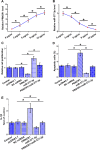Long non-coding PRNCR1 regulates the proliferation and apoptosis of synoviocytes in osteoarthritis by sponging miR-377-3p
- PMID: 35422021
- PMCID: PMC9008967
- DOI: 10.1186/s13018-022-03035-2
Long non-coding PRNCR1 regulates the proliferation and apoptosis of synoviocytes in osteoarthritis by sponging miR-377-3p
Abstract
Background: LncRNA PRNCR1 has been reported to be involved in LPS-induced inflammation, which contributes to osteoarthritis (OA). We predicted that miR-377-3p could bind to PRNCR1.MiR-377-3p can suppress OA development. We therefore analyzed the potential interaction between them in OA.
Methods: Expression of miR-377-3p and PRNCR1 in both OA (n = 40) and control (n = 40) samples were analyzed by RT-qPCR. MiR-377-3p or PRNCR1 were overexpressed in synoviocytes to explore their potential interaction. The subcellular location of PRNCR1 was analyzed by nuclear fractionation assay. The direct interaction between miR-377-3p and PRNCR1 was analyzed by RNA-pull down assay. The proliferation and apoptosis of synoviocytes were analyzed by BrdU and apoptosis assay, respectively.
Results: PRNCR1 was overexpressed in OA, while miR-377-3p was downexpressed in OA. PRNCR1 was detected in the cytoplasm and directly interacted with miR-377-3p. Interestingly, overexpression of PRNCR1 and miR-377-3p showed no regulatory role in each other's expression. LPS treatment increased PRNCR1 expression and decreased miR-377-3p expression. PRNCR1 overexpression decreased LPS-induced synoviocyte proliferation and increased LPS-induced synoviocyte apoptosis. MiR-377-3p played opposite roles in cell proliferation and apoptosis. Moreover, PRNCR1 suppressed the role of miR-377-3p.
Conclusions: Therefore, PRNCR1 is was detected in cytoplasm and regulates synoviocyte proliferation and apoptosis in OA by sponging miR-377-3p.
Keywords: Apoptosis; Osteoarthritis; PRNCR1; Proliferation; miR-377-3p.
© 2022. The Author(s).
Conflict of interest statement
All other authors declare that we do not have any commercial or associative interest that represents a conflict of interest in connection with the work submitted.
Figures




Similar articles
-
Long intergenic non-protein coding RNA 00707 regulates chondrocyte apoptosis and proliferation in osteoarthritis by serving as a sponge for microRNA-199-3p.Bioengineered. 2022 Apr;13(4):11137-11145. doi: 10.1080/21655979.2022.2061287. Bioengineered. 2022. PMID: 35485364 Free PMC article.
-
Circular RNA circCTNNA1 is downregulated in osteoarthritis and sponges miR-29a to suppress LPS-induced apoptosis of synoviocytes.Immunopharmacol Immunotoxicol. 2022 Feb;44(1):1-6. doi: 10.1080/08923973.2021.1988103. Epub 2021 Nov 9. Immunopharmacol Immunotoxicol. 2022. PMID: 34751080
-
Long non-coding RNA LINC00265 promotes proliferation, apoptosis, and inflammation of chondrocytes in osteoarthritis by sponging miR-101-3p.Autoimmunity. 2021 Dec;54(8):526-538. doi: 10.1080/08916934.2021.1978432. Epub 2021 Oct 11. Autoimmunity. 2021. PMID: 34633248
-
Knockdown of lncRNA MFI2-AS1 inhibits lipopolysaccharide-induced osteoarthritis progression by miR-130a-3p/TCF4.Life Sci. 2020 Jan 1;240:117019. doi: 10.1016/j.lfs.2019.117019. Epub 2019 Oct 31. Life Sci. 2020. PMID: 31678554 Review.
-
A review on the role of PRNCR1 in human disorders with an especial focus on cancer.Pathol Res Pract. 2022 Sep;237:154026. doi: 10.1016/j.prp.2022.154026. Epub 2022 Jul 13. Pathol Res Pract. 2022. PMID: 35849867 Review.
Cited by
-
The emerging role of lncRNAs in osteoarthritis development and potential therapy.Front Genet. 2023 Sep 14;14:1273933. doi: 10.3389/fgene.2023.1273933. eCollection 2023. Front Genet. 2023. PMID: 37779916 Free PMC article. Review.
References
-
- Prieto-Alhambra D, Judge A, Javaid MK, Cooper C, Diez-Perez A, Arden NK. Incidence and risk factors for clinically diagnosed knee, hip and hand osteoarthritis: influences of age, gender and osteoarthritis affecting other joints. Ann Rheum Dis. 2014;73(9):1659–1664. doi: 10.1136/annrheumdis-2013-203355. - DOI - PMC - PubMed
MeSH terms
Substances
LinkOut - more resources
Full Text Sources
Medical

